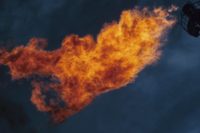Missed opportunities to apply inherently safer design, failure to identify and evaluate damage mechanism hazards, and the lack of effective safeguards culminated in the vapor cloud release and massive fire that occurred at the Chevron refinery on August 6, 2012,a draft report by the U.S. Chemical Safety Board (CSB) has found. The investigation team concluded that enhanced regulatory oversight with greater worker involvement and public participation are needed to improve oil refinery safety.
The report, subject to a Board vote at a CSB public meeting in Richmond on Friday, April 19, notes that Chevron repeatedly over a ten-year period failed to effectively apply inherently safer design principles and upgrade piping in its crude oil processing unit that was extremely corroded and ultimately ruptured on August 6, 2012. The ensuing release of hydrocarbons endangered 19 workers who narrowly escaped from a vapor cloud before it ignited, causing a fire that sent a plume across the area. 15,000 people sought medical treatment in the weeks following the accident.
| Had Chevron followed its own internal recommendations, it would have years ago upgraded critical crude unit sidecut piping from carbon steel to metallurgy more resistant to sulfidation corrosion. Such a material upgrade could have prevented the accident |
The public meeting to consider the draft report is scheduled for Friday, April 19, at 6:30 p.m. at the Richmond Memorial Auditorium and Convention Center, 403 Civil Center Plaza, Richmond. The meeting will include a detailed presentation by CSB investigators, a computer-animated video recreation of the incident, a stakeholder panel discussion, and a public comment period.
"Urgent" recommendations for Chevron
The CSB investigation team proposed to the Board urgent recommendations, including that at all its refineries, Chevron perform damage mechanism hazard reviews and ensure safeguards are in place to control identified hazards. Reporting of process safety indicators to enable more effective oversight by federal, state, and local regulatory agencies is also urgently recommended.
The refinery is located in the city of Richmond; a Contra Costa County community located about ten miles northeast of San Francisco. A series of recommendations are proposed to the mayor and city council of Richmond, and the Contra Costa County supervisors, aimed at strengthening the local Industrial Safety Ordinance and driving the risk of major accidents as low as reasonably practicable.
The report recommends the governor and legislature of the State of California create amulti-agency program for all California oil refineries to improve the public accountability, transparency and performance of process safety programs. The EPA was urged to assist the state to monitor the effective implementation of programs designed to improve oil refinery safety and disclosure requirements the CSB is recommending to the state and local agencies.
A national need
CSB Chairperson Rafael Moure-Eraso said, “Improved worker involvement, company transparency, and public participation are needed to prevent these major industrial accidents. Our findings and recommendations are directed immediately at the accident in the Bay Area, but we believe they apply to all refineries, chemical plants and general industry. There is a national need to base safety principles on inherently safer designs and applying effective safeguards to control damage mechanisms such as sulfidation corrosion. And we find that to prevent chemical accidents, regulatory agencies must maintain sufficient professional expertise to effectively oversee these highly technical industries.”
| “Chevron has repeatedly failed to implement the proposed inherently safer recommendations.” |
The CSB investigation team determined that although Chevron policy calls for the use of inherently safer technology in design and upgrades, the company has been implementing changes – such as the critical metallurgy of piping – without any documented, thorough analysis of the proposed inherently safer solutions. The investigators wrote, “Without such a review, the material selected cannot be analyzed to determine if it is the best inherently safer solution for the process in order to minimize risk.” The report continues, “Chevron has repeatedly failed to implement the proposed inherently safer recommendations.” Had this been done, the investigation team concluded, the accident could have been prevented.
The CSB investigation team determined that had Chevron followed its own internal recommendations, or been required by local, state or federal regulation to implement inherently safer systems during repairs, it would have years ago upgraded critical crude unit sidecut piping from carbon steel to metallurgy more resistant to sulfidation corrosion – metal deterioration caused by the presence of sulfur compounds at high temperatures in the crude unit. Such a material upgrade could have prevented the accident.
Inconsistent use of materials
Even when rebuilding the crude oil unit after the August 2012 release and fire, the CSB report notes, Chevron did not install what the CSB considers inherently safer stainless steel piping in the destroyed distillation tower, choosing instead, with no documented inherently safer technology review, an alloy called 9-Chrome that is more corrosion-resistant than carbon steel but less resistant than stainless steel. The report notes this was despite the fact that the company did install stainless steel piping in the 4-sidecut section of the distillation tower in a nearly identical refinery unit in El Segundo, California in 2001, considering it to be the safest material.


